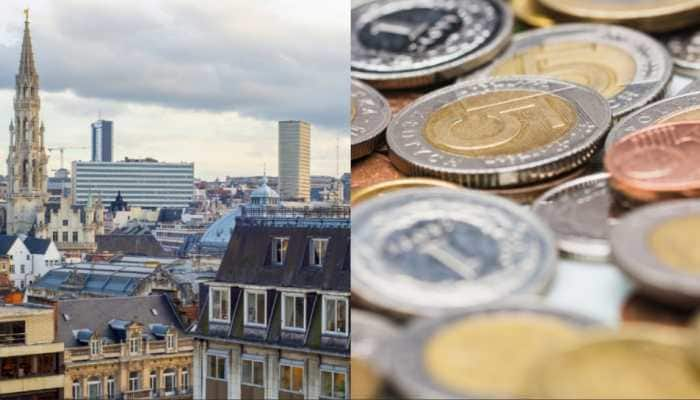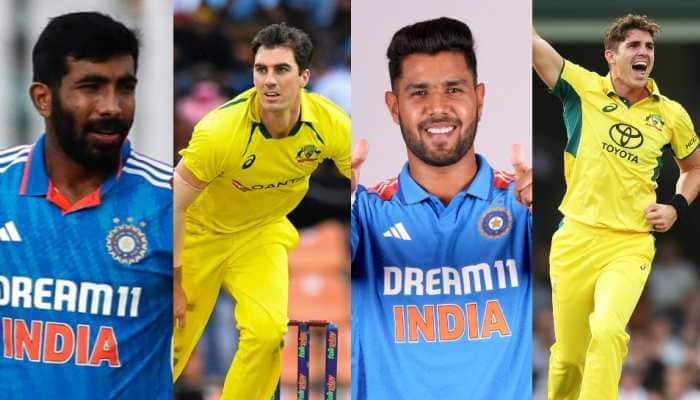History Revisited: How political parties fared in 2014 Lok Sabha election
Ahead of the 2014 Lok Sabha election, there was a change of guard in the BJP. Veteran leader LK Advani was replaced by the then Gujarat Chief Minister Narendra Modi as the party's PM face in September 2013.
Trending Photos
)
Manmohan Singh led United Progressive Alliance government was heading completion of its second full five-year term in office in 2014. Singh's second term was clouded with several controversies with allegations of scams like coal block allocation, 2G spectrum case, AgustaWestland chopper deal, and Commonwealth Games scam. The economy was also experiencing slow growth, high inflation rate with an exponential rise in prices of onions and salt becoming a major issue. The UPA government was facing anti-incumbency as it neared the 2014 election dates.
Also Read: History of Lok Sabha elections
Singh had announced that he was out of the PM race, leading to the speculations yet again that the then Congress vice president Rahul Gandhi would be projected as the party's prime ministerial face. Rahul also maintained that he was ready to take up whatever responsibility the party would trust him with. The Congress-led United Progressive Alliance, however, stopped short of announcing any PM candidate and said that the decision will be taken once the result is announced.
On the other hand, it was a change of guard in the Bharatiya Janata Party. Veteran leader LK Advani was replaced by the then Gujarat Chief Minister Narendra Modi as the party's PM face in September 2013. The decision to name him the PM candidate is said to have been opposed by several BJP members including Advani. The veteran leader had even resigned from all party posts to convey his resentment. However, he went back on his decision and withdrew his resignation just a day later. Advani had felt that Modi's anointment should be deferred till a later date as assembly polls were due in Madhya Pradesh, Chhattisgarh, Rajasthan, and Delhi. He believed that by making Modi the PM candidate, issues like price rise and corruption will take a back seat and the heat will be around Modi's controversial past. The BJP, though, went ahead with the announcement stating that the decision has been made "unanimously" keeping into account the mood and aspirations of the people.
The election was to be held in nine phases from 7 April to 12 May.
Seeking a third term for the party, the Congress was trying to convince the electorate of the work done by the government in the past 10 years and the road that it had set for the country. Sticking to its secular image, Congress maintained that it would promote social harmony and issues of national interest if it comes back to power. However, the corruption scandals which had hit the party hard during the term were taking the stage away from the Congress. The exit polls predicted that the grand old party was on its way out and that the Modi wave was tilting the balance in favor of the BJP.
As part of his campaign, Modi was trying to touch the nerves of the people by promising growth and projecting Gujarat as the model of development. The tagline 'ache din aayenge' and its vow to ensure 'minimum government, maximum governance' had become synonymous to BJP and Modi in the 2014 election. The BJP reached out to the people with the slogan of "nayi soch, nayi ummeed" projecting Modi as an alternative to the 'corrupt' government.
Over the months, Modi had become a brand. The party was working as an organisation with a marketing and branding campaign designed around Modi. His image had been transformed from a regional, right-wing politician to a leader who had a clear vision for growth and development and one who echoed with the youth and the old alike.
The BJP realised the importance of social media. From Facebook, YouTube to Twitter, the BJP tapped into all platforms to magnify the impact of the campaign. Another strategy that worked in the BJP's favour was the one derived out of Congress leader Mani Shankar Aiyer's remark on the Modi's past where he worked as a tea seller with his father. The BJP used the insult as a campaign strategy to strike a chord with the common man. It launched 'chai pe charcha' where he held discussions with people over a cup of tea on good governance and questioned the 'sense of entitlement' that he alleged that the Congress has.
On one hand, Modi, being an excellent orator, was taking the centrestage for the BJP, on the other hand, Congress was left wanting. Rahul had taken charge of the party's campaign but his experience paled in comparison to a three-time chief minister.
After months of campaigning and an over a month-long voting schedule, the counting was held on 16 May.
Surpassing all expectations, the BJP won an absolute majority with 282 seats creating history by becoming the first non-Congress party to have ever crossed the magic number in the 67-year history of independent India. It made its biggest mark in Uttar Pradesh where the party, which had won only ten seats in the 2009 election, bagged 71 out of 80 seats in 2014. Modi registered a historic victory in Varanasi, from where he was fighting the election. The party swept states like Gujarat, Rajasthan, Delhi and where it bagged all its 26, 5 and 7, 5 seats respectively.
Among the NDA partners, Shiv Sena bagged 18 out of 20 seats it contested on, Telugu Desam Party won 16 of the 30 seats, Lok Janshakti Party won 6 of 7 seats, Shiromani Akali Dal won 4 out of 10 seats, Rashtriya Lok Samta Party won all 3 seats it contested on. In total, the partners took the NDA tally to 336 in the 543 member Parliament.
| HOW BHARATIYA JANATA PARTY FARED | HOW CONGRESS FARED | ||
|---|---|---|---|
| States | Seats won | States | Seats won |
| Andaman & Nicobar Islands | 1 | Andaman & Nicobar Islands | 0 |
| Andhra Pradesh | 3 | Andhra Pradesh | 2 |
| Arunachal Pradesh | 1 | Arunachal Pradesh | 1 |
| Assam | 7 | Assam | 3 |
| Bihar | 22 | Bihar | 2 |
| Chandigarh | 1 | Chandigarh | 0 |
| Chhattisgarh | 10 | Chhattisgarh | 1 |
| Dadra & Nagar Haveli | 1 | Dadra & Nagar Haveli | 0 |
| Daman & Diu | 1 | Daman & Diu | 0 |
| Goa | 2 | Goa | 0 |
| Gujarat | 26 | Gujarat | 0 |
| Haryana | 7 | Haryana | 1 |
| Himachal Pradesh | 4 | Himachal Pradesh | 0 |
| Jammu & Kashmir | 3 | Jammu & Kashmir | 0 |
| Jharkhand | 12 | Jharkhand | 0 |
| Karnataka | 17 | Karnataka | 9 |
| Kerala | 0 | Kerala | 8 |
| Lakshadweep | 0 | Lakshadweep | 0 |
| Madhya Pradesh | 27 | Madhya Pradesh | 2 |
| Maharashtra | 23 | Maharashtra | 2 |
| Manipur | 0 | Manipur | 2 |
| Meghalaya | 0 | Meghalaya | 1 |
| NCT OF Delhi | 7 | Mizoram | 1 |
| Odisha | 1 | Nagaland | 0 |
| Punjab | 2 | NCT OF Delhi | 0 |
| Rajasthan | 25 | Odisha | 0 |
| Sikkim | 0 | Puducherry | 0 |
| Tamil Nadu | 1 | Punjab | 3 |
| Tripura | 0 | Rajasthan | 0 |
| Uttar Pradesh | 71 | Sikkim | 0 |
| Uttarakhand | 5 | Tamil Nadu | 0 |
| West Bengal | 2 | Tripura | 0 |
| Uttar Pradesh | 2 | ||
| Uttarakhand | 0 | ||
| West Bengal | 4 | ||
| TOTAL | 282 | TOTAL | 44 |
While BJP registered its best-ever tally, the Congress hit rock bottom. From 206 in the last election, it fell down to just 44 seats. In Uttar Pradesh, apart from Rahul's Amethi and Sonia Gandhi's Rae Bareli constituency, the Congress could not win even a single other seat. The party could just win 9 seats in Karnataka, 8 in Kerala, 4 in West Bengal, 3 in Punjab, 2 each in Madhya Pradesh, Maharashtra and Manipur, 1 each in Chhattisgarh, Haryana, Meghalaya, and Mizoram.
Rahul, being the face of the party's campaign, took the responsibility of the defeat, but Congress jumped in his defense backing him for his leadership. "The campaign went wrong but considering the limited amount of time that Rahul had in his hands, he did a commendable job. Every party has its ups and downs, there is no need for him to quit," Congress leader Jyotiraditya Scindia had said, a sentiment that other Congress leaders echoed.
(Read: All you need to know about 2009 Lok Sabha election)
The All India Anna Dravida Munnetra Kazhagam (AIADMK), which fought the poll alone, registered a huge victory in Tamil Nadu, winning 37 out of the 39 seats. Ahead of the election, West Bengal Chief Minister Mamata Banerjee had also announced that she would not get into any alliance with either the BJP or Congress and would contest alone. The decision rolled in favour of the party as it won 34 of the 42 seats in West Bengal.
| PARTY NAME | NO OF CONTESTANTS | SEATS WON | VOTE PERCENTAGE |
|---|---|---|---|
| Bharatiya Janata Party | 428 | 282 | 31 |
| Communist Party of India | 67 | 1 | 0.78 |
| Communist Party of India (Marxist) | 93 | 9 | 3.25 |
| Indian National Congress | 464 | 44 | 19.31 |
| Nationalist Congress Party | 36 | 6 | 1.56 |
| Aam Aadmi Party | 432 | 4 | 2.05 |
| All India Anna Dravida Munnetra Kazhagam | 40 | 37 | 3.27 |
| All India N.R. Congress | 1 | 1 | 0.05 |
| All India Trinamool Congress | 131 | 34 | 3.84 |
| All India United Democratic Front | 18 | 3 | 0.42 |
| Biju Janata Dal | 21 | 20 | 1.71 |
| Indian National Lok Dal | 10 | 2 | 0.51 |
| Indian Union Muslim League | 25 | 2 | 0.2 |
| Jammu & Kashmir Peoples Democratic Party | 5 | 3 | 0.13 |
| Janata Dal (Secular) | 34 | 2 | 0.67 |
| Janata Dal (United) | 93 | 2 | 1.08 |
| Jharkhand Mukti Morcha | 21 | 2 | 0.3 |
| Kerala Congress (M) | 1 | 1 | 0.08 |
| Lok Jan Shakti Party | 7 | 6 | 0.41 |
| Naga Peoples Front | 2 | 1 | 0.18 |
| National Peoples Party | 7 | 1 | 0.1 |
| Pattali Makkal Katchi | 9 | 1 | 0.33 |
| Rashtriya Janata Dal | 30 | 4 | 1.34 |
| Revolutionary Socialist Party | 6 | 1 | 0.3 |
| Samajwadi Party | 197 | 5 | 3.37 |
| Shiromani Akali Dal | 10 | 4 | 0.66 |
| Shivsena | 58 | 18 | 1.85 |
| Sikkim Democratic Front | 1 | 1 | 0.03 |
| Telangana Rashtra Samithi | 17 | 11 | 1.22 |
| Telugu Desam | 30 | 16 | 2.55 |
| All India Majlis-E-Ittehadul Muslimeen | 5 | 1 | 0.12 |
| Apna Dal | 7 | 2 | 0.15 |
| Rashtriya Lok Samta Party | 4 | 3 | 0.19 |
| Swabhimani Paksha | 2 | 1 | 0.2 |
| Yuvajana Sramika Rythu Congress Party | 38 | 9 | 2.53 |
| Independent | 3235 | 3 | 3.02 |
| TOTAL | 8251 | 543 | 98.92 |
Biju Janata Dal also witnessed a remarkable result winning 20 of the 21 seats in Odisha that it contested on. Mayawati's Bahujan Samaj Party became the party with the third largest vote share in the election but failed to win even a single seat.
The result was historic both for the BJP and the Congress - one with its best-ever tally and the other with its worst. This was the highest number of seats won by any party on its own since the 1984 Lok Sabha elections, which were held after the assassination of former PM Indira Gandhi where the party bagged 403 seats. Such was the mandate in favour of the BJP that the none of the other parties were able to even become the official opposition party as to get to that position a party must gain 10 per cent ie 55 seats in the Lok Sabha. The 16th Lok Sabha would thus go on to complete its term without a Leader of the Opposition.
India has won! भारत की विजय। अच्छे दिन आने वाले हैं। — Chowkidar Narendra Modi (@narendramodi) May 16, 2014
Soon after the results, Modi acknowledged the people's mandate and tweeted: "India has won!" along with his famous tagline acchhe din aane wale hai. He added "with all and development for all, will be my government’s motto and not an empty slogan." He took the oath as the 15th Prime Minister of India on 26 May 2014 in a ceremony which was attended by heads of all SAARC countries.
Stay informed on all the latest news, real-time breaking news updates, and follow all the important headlines in india news and world News on Zee News.
Live Tv







)
)
)
)
)
)
)
)
)
)
